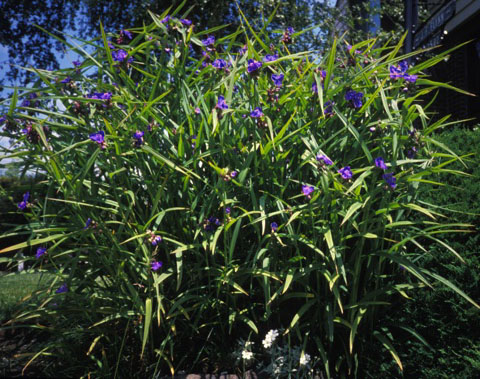
|
| Spiderwort; Tradescantia virginiana L. |
Spiderwort Family; COMMELINACEÆ
|
| Spiderwort is the ugly name of a lovely plant. Don't be put off by it. The plant is pretty enough that it might just as well have been known as "blue jacket" or some other nicer name. But it was called "spiderwort" for a reason. Why? According to George Iles, who wrote a wildflower book in 1894: |
| "About flowers that open only to wither there is a tender charm. These are the dragon flies of the plant world, ephemeral beauties . . . fading like vapor in the light of the sun. Such are the delicate blossoms of the spiderflower. Brave and hardy they look in their dress of rich purple, till the hot sun blasts them. Then they melt away like wax. The withered, mucilaginous petals can be drawn out into fine threads like those of a spider's web, hence the popular name." |
| John Tradescant, Dutch gardener to King Charles I, died in about 1652, and in the 1700s Linnaeus named the genus after him. Tradescantia is a New World genus of at least 35 species whose range stretches from Manitoba to Argentina. |
| Best known in cultivation today are a tender South American houseplant "Wandering Jew" (Tradescantia fluminensis), and hardy perennials that are sold either as Tradescantia virginiana or as Tradescantia x Andersoniana, an invalid name. It is amazing how hybridization improves the plain, ordinary spiderwort of meadows and roadsides. They become wonderful garden plants. It is like taking a bit of lime and sand to make concrete: the result seems greater than the sum of its parts! |
| Spiderworts were once considered old fashioned border flowers, whose value consisted in brilliant blue flowers freely borne from late spring through early summer. In this respect they are quite like some gentians, campanula or perhaps Jacob's ladder. But the spiderwort's leaves are clearly iris- or grass-like, only softer and limper, with a distinctive sheath where leaf meets stem. Also, the flowers, supplied in generous clusters atop gracefully nodding stems a foot or two high, are set off by conspicuous long leaf-like bracts. All of which amounts to spiderworts being a class unto themselves, not very like other garden flowers. |
Though these interesting plants are fairly well spread, and are not rare in cultivation, their only vernacular name at all much used is spiderwort. They must not be confused with:
|
| Spider Flower (Cleome) |
| Spider Lily (Hymenocallis and Lycoris) |
| Spider Orchis (Ophrys sphegodes) |
Spider Plant (Chlorophytum comosum)
|
| Unlike these others, spiderworts are superb indicators of radiation levels, since their flowers are highly sensitive to radiation damage. |
| Since spiderworts are pretty and easily grown, they've long been prized by gardeners. In nature the various North American species can be found in dry, sandy, sunny sites, where they bloom well but not for long; and in moist woodland edges, roadside ditches, and seep areas where they grow vigorously and bloom for months. |
| The best of the wild species and their hybrids (many cultivars) have flowers of purple, blue, violet, red, pink or white, beginning in late April and continuing into late July or even longer. Each flower lasts only one day (signifying transient happiness in the Language of Flowers), but since the plant makes hundreds of flowers there is a long season indeed. The most highly treasured cultivars have 3-inch large, very blue flowers. |
| The plants are clumped and spread slowly. The hybrids do not set seed but are divided easily. Almost any soil or light conditions are acceptable, and pests or diseases are practically nonexistent, so spiderworts prove ideal additions to most gardens. There is a slight drawback: some taller stems flop over, looking ungainly. But spiderwort's virtues outweigh its vices. Although the deep blue flowers with the bright yellow anthers are highly decorative, even if this were not the case I would still grow the herb because its leaves are good food, and not only for slugs! |
Whenever it is possible to pluck fresh young spiderwort leaves, I eat them in salads or mixed in sandwiches along with daisy leaves, chives, cabbage, etc. They add juicy succulent crunch, nutrition, and a mild, almost insignificant flavor. Evidently they have no medicinal potency, judging from their absence in herbal medical literature. They are more like daylily leaves than anything else I've eaten, but are not as acrid and have a longer season. My garden has four different kinds and shall have still more, as I make an effort to learn just which have the best leaves over the longest season. The flowers, too, are a splashy addition to salads.
|
(Originally published in the April 1990 Seattle Tilth newsletter, along with an illustration by Annie Figliola.)
Back |

